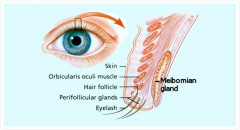Dry Eye Center of Arizona
3805 E Bell Rd
Suite 1800
Phoenix, AZ 85032
CALL TODAY FOR AN APPOINTMENT
Phone (602) 549-2020
Fax: (602) 325-5536
dryeyecenter@gmail.com
Or use our contact form.
Office Hours
Our office is open during the following hours:
Mon-Friday: 9AM - 6PM
Doctor's Hours: By Appointment Only
LipiFlow Treatment
The Causes of Dry Eye
Dry eye is typicaly chronic and progressive, but it can also be transient or episodic. Dry eye is more frequently seen in females than males and is more common with increasing age. It is among the best examples of a multi-factorial disorder. In other words many different things can both cause or contribute to dry eye.
The number one cause of dry eye is meibomian gland dysfunction. The meibomian glands are small oil producing glands that run radially through down upper and lower lids. They are compressed by the lids with each blink and express a small amount of complex lipid that bonds with underlying tear structure to stabilize it and prevent evaporation. Recent research suggests that meibomian gland dysfunction (MGD) is responsible for or contributes to nearly 90% of all cases of dry eye.
Dry eye can be associated with systemic disorders such as rheumatoid arthritis, lupus, thyroid disease and Sjögren's syndrome, which causes inflammation and drying of mucous membranes of the eyes and mouth. Hormonal changes can also cause dry eye, which sometimes occurs during pregnancy.
In addition to MGD, eye conditions associated with dry eye include allergy, trauma, infection, and chemical burns to the ocular surface. Eye surgeries like LASIK and cataract procedures and cosmetic procedures involving the eye can also lead to dry eye.
Medications can also cause dry eye. These include medications for allergy, hypertension, Parkinson’s syndrome, anxiety, depression and even birth control pills. Both systemic and topical medications can cause dry eye. Note that non-prescription medications like antihistamines can cause significant dry eye.
Dry eye can also be situational or environmental. Patients living in arid areas like Arizona and high elevations like Denver are particularly prone to dry eye. However dry eye is common in areas where significant indoor-outdoor variations are common. This is true of tropical climates where people transit between hot high humidty outdoor conditions and cool and very dry air conditioned environments. Dry eye is also typically worsenedby close work especially work that reduces blink rates or interferes with full eyelid closure.
More information on dry eye can be found in the sections on The Normal Tear Film, What is Dry Eye?, Diagnosing Dry Eye, and Dry Eye Therapy.





